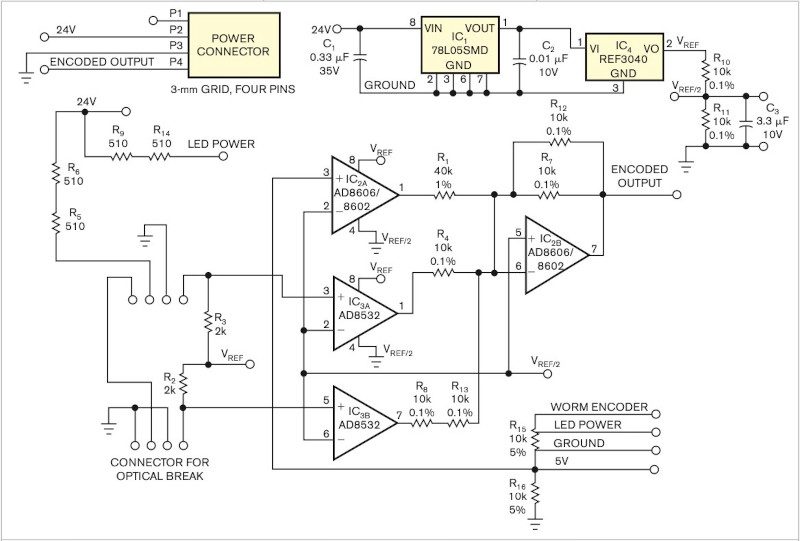It’s been a running battle in some quarters for years, whether analog sensor processing is better than digital. Proponents of digital are sometimes driven by lack of familiarity with analog circuitry, while analog die-hards point to delays and software crashes in microcontrollers. We’d probably toe the line that a mixture of the two skills is best, but [paul] has gone full-on for the analog side with his position and limit sensor for a remote telescope. The ‘scope had only one control wire carrying a digital signal, so how was he to get extra information down it? The solution was to overlay a DC voltage, and use a summing network composed of a series of op-amps to encode position and limit data as voltage.
In operation, the circuit is a straightforward DC summing amplifier of the type that op-amps were designed for and at which they excel. We’re not so sure it needs the high-precision resistors and the choice of op-amps seems the wrong way round with the AD8532’s high current output being better suited to driving the line than straightforward summing, but we can see it does the job. If you’re after a demonstration of a DC summing amplifier using an op-amp, here’s your project. Meanwhile if you’re curious about an op-amp inside the black box, take a look at one of the simplest integrated circuit op-amps ever made.

















My little entries for the op-amp challenge, if anyone cares :)
https://www.robots-everywhere.com/re_wiki/pub/web/Cookbook.2pin2motor.html How to use two bidirectional pins to control two motors. Also does level shifting. Uses a LM324 or similar op amp.
https://www.robots-everywhere.com/re_wiki/pub/web/Cookbook.AudioSerial.html Very simple way to control things with cheapie Android phones. This is old and made more sense when bluetooth adapters were more expensive. Uses any op amp, really.
>”How do you encode that with the 1 already-in-use digital signal wire we had available?”
Parallel in, serial out shift register clocked by an oscillator. No MCU involved, no software to crash, no need to reset it. Just start listening when convenient. Example part: 74HC166
Or a 1-wire port expander like the DS2408. These can be daisy-chained, so you get practically unlimited bi-directional IO that only needs power, ground, and one signal wire.
Sorry, not daisy chained – they can exist along the same bus in parallel.
For most asynchronous communication protocols you only need a single wire to send a signal one way and can sometimes manage bidirectional communication. It might be possible to have a microcontroller receive a signal at the telescope and then pass it to the telescope or do something else with it.
Analogue signals aren’t always that reliable due to interference.
It depends on what you are wanting to accomplish and how far you are running the signal.
They didn’t want an MCU at the telescope end.
4-20 mA current loops are pretty resilient. Most industrial sensors and PLCs use that scheme when they need to transmit continuous values. Analog voltages are typically used for local control, like command values out of a user panel, then passed along by a digital serial field bus towards other nodes, and then in/out of sensors and various actuators in analog mode again.
One advantage is that you can stick a multimeter in there and diagnose the problem on the spot. When you’re tapping into a digital serial line, that may or may not be broken, it’s hard to diagnose what’s going on and it requires specialized equipment and special training.
What’s that stuff at the bottom right? GROUND and 5V are both connected to bottom of R15 ? LED POWER taps half way the resistor ?
If you can’t trust someone to avoid an immediate short circuit, you can’t trust any other aspect of the design.
Then again, maybe it’s like the old Thomas street maps with deliberate mistakes to catch copy cats. Or more likely a corrected version to be posted in 10… 9… 8…